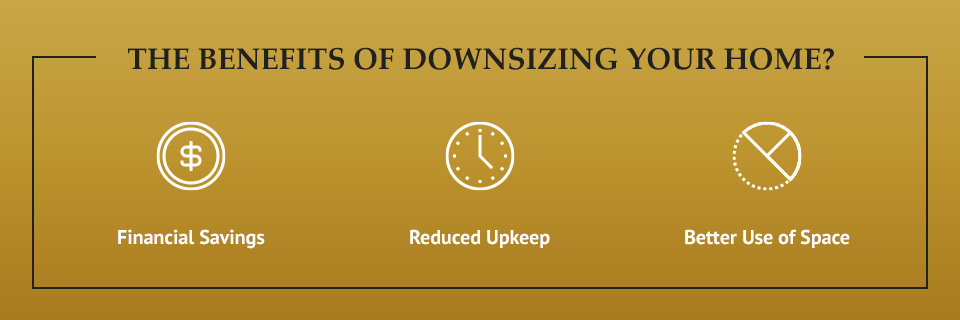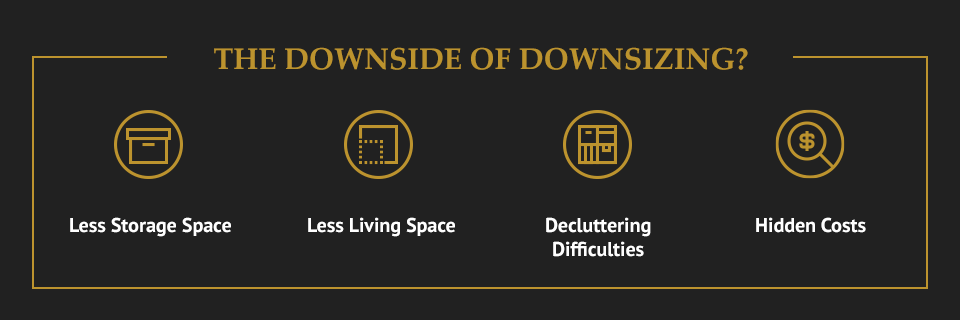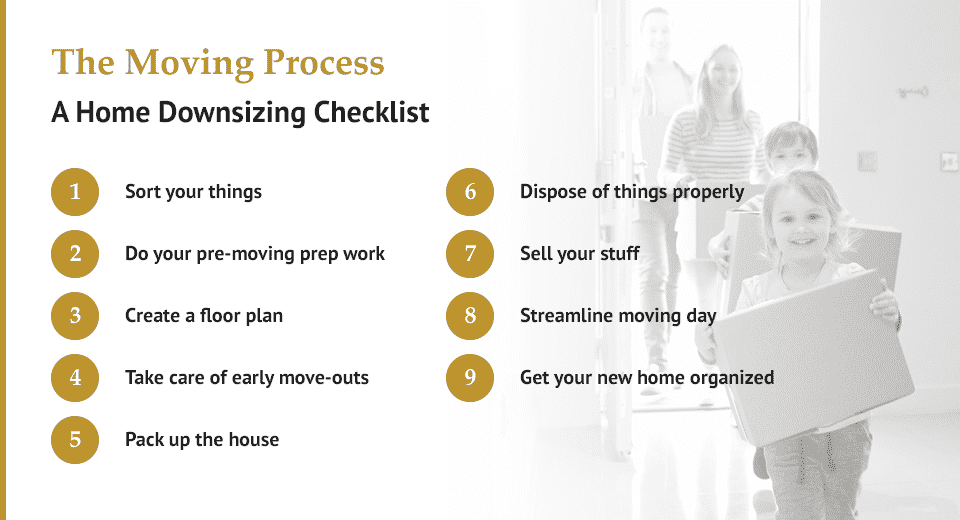
Decluttering, getting rid of things, and moving into a smaller space is a well-trodden road for families all across the nation. If you’re thinking about, or in the beginning stages of downsizing your home, you are not alone by any means.
Every stage of life could bring about reasons to downsize. Young couples who want to move in together have to discard duplicate items. Empty-nesters may consider a smaller home to suit their child-free routines. Retirees may want to spend less time and money maintaining a larger home. Individuals on whom age is taking its toll — and their families — may find themselves searching for extra assistance in a care facility. Even though it can be challenging, downsizing is part of life everyone will eventually experience.
Whether you’re looking to save money or distress your life, and whether you are downsizing your home with kids or for a loved one, you can benefit from knowing both the advantages and disadvantages of downsizing a home and the steps to do it most efficiently.
Table of Contents
WHAT ARE THE BENEFITS OF DOWNSIZING YOUR HOME?
Essentially, downsizing offers a range of benefits related to escaping frivolous living, from financial savings to a more concentrated, simpler lifestyle. Despite the work and time that goes into it, getting rid of your excess stuff and having less to maintain can be an incredibly refreshing move — and one that pays off in the long run.

Benefit 1: Financial Savings
One of the primary reasons people consider home downsizing is to save money. Smaller homes ensure a smaller mortgage, lower utility costs, less maintenance expense, and lower property insurance. If you are selling your old home, you can use the profits to buy your new place in cash, eliminating your mortgage payment entirely.
Another financial benefit is the increased cash flow downsizing offers. No longer will the equity of your home be tied up in maintenance and furnishings, but instead, you can invest it, put it in the bank to build up your savings, and use the extra money to fund your more exciting pursuits, like hobbies and traveling.
Benefit 2: Reduced Effort on Upkeep
Not only are you downsizing your home to save money, but you are also saving time and energy you usually invest in maintaining your large home. No longer will you spend hours cleaning rooms you barely use and doing tedious yard work. You can now use that time for the fun things you’ve always wanted to do.
Less maintenance is probably the most significant reason downsizing your home for retirement is such an appealing idea. If you’ve already spent enough time and energy working hard, why not reduce the time it now takes to maintain your lifestyle and do the things that bring you the most joy? You’ll be thrilled to find fewer responsibilities and a lower workload that grants you the flexibility to pursue dreams and reduce your stress.
Benefit 3: Better Use of Space
You might be surprised to learn some of the recent statistics on how much stuff we own. For example, on average, American houses contain 300,000 items, and despite these houses having tripled in size over the past 50 years, one out of 10 families continues to rent offsite storage space for additional keepsakes or furniture. Additionally, the average home is nearly 2,700 square feet, 80 percent of which is space we rarely, if ever, use.
Not only is this a waste of real estate, but the cost of maintaining so many belongings can be astronomical, both financially and upkeep-related. Why continue spending so much time, energy, and money on things we don’t use and space we don’t need? Downsizing can lead to a fuller life of less excess, which makes people much happier overall, research shows.
WHAT IS THE DOWNSIDE TO DOWNSIZING?
The main disadvantage downsizing could pose is discontent if the timing is not right. Heavy emotional attachment to things, stressful life events, financial burdens, and other factors may indicate right now is not the best time to be thinking about making a lifestyle overhaul. It can feel overwhelming. Here are a few downsides to downsizing for you to consider.

An emotional experience: Many people downsizing are leaving a home full of lifetime memories. Even those looking forward to a move can be surprised how emotional it is to say good-bye to the place you reared children and celebrates life’s milestones.
Less storage space: While this may surprise you, it can be easy to forget giving up space means less room for all the furniture and belongings we are so used to enjoying. The china cabinet that has been in the family for generations may need to find a new home, the boxes of children’s elementary school artwork in the garage, and all the dusty memories in the attic may not all fit in the new place.
Less living space: More intimate living situations may turn out to be challenging for some. Having to share or not having room for guests could make space constraints problematic. With this, you’ll also need to consider: If you had a family crisis that necessitated a relative staying with you, would you be able to share spaces, like the single bathroom?
Decluttering difficulties: It can be challenging to let go of family heirlooms that no longer fit or get rid of a closet full of clothing you used to love wearing. It can be heart-wrenching to finally sell that collection you acquired from years of travelling., or throw out the small knickknacks you or a loved one has grown accustomed to hoarding.
Hidden costs: Despite the fact that downsizing your home will save money in the long run, there is a good chance there will be other costs during the relocation process. These include HOA fees, transactional costs of buying and selling homes, a change in taxes, investing in smaller furniture and storage items to fit inside the new home, and the costs of hiring professionals to help you move.
To minimize the amount of time and money it will cost you to get rid of the things you can’t or don’t want to keep, consider the benefits of auctioning your home as a selling alternative that can get you the exposure you need to find the right buyer. You might be surprised to find eliminating some of the legwork helps relieve some of the stress and burden downsizing can cause, while also getting you maximum value.
HOW CAN YOU KNOW IF IT’S TIME FOR YOU TO DOWNSIZE?
Since it is primarily a lifestyle decision, determining when you should downsize your home is all about evaluating how your space complements the lifestyle you desire for yourself.
It may be time to downsize if your house is filled with “just-in-case” furniture items, duplicate kitchen appliances, multiple bedrooms that remain empty for extended periods of time, spaces that take too much time to clean or renovation projects that sap all your energy. If you hire help for tasks you used to do yourself, it may be a sign a change would be welcome.
You may also think about whether your current home is close enough to the things you enjoy most, whether it’s family members or just the part of town you love. Why continue living in the suburbs if you’re an empty-nester who’d rather be closer to work or downtown? Retirees often downsize to be closer to services they depend on.
Assuming your current home no longer fits the lifestyle you want or the income and energy you have, you should look for something more suitable, and your search for a new home should definitely reflect that.
STEPS TO DOWNSIZING YOUR HOME: HOW TO DOWNSIZE THE RIGHT WAY
First and foremost, prepare as best as you can by starting the process early. Begin asking questions and decluttering gradually, well before the need to move arises. Streamlining the process will help minimize the pain of releasing the stuff you’ve accumulated, and maybe you’ll even find yourself enjoying paring it down. Start by taking a look at the big picture.
1. Determine Your Needs: Ask Big-Picture Questions
Asking the right questions to figure out your needs and goals is the perfect first step to preparing for the huge life event downsizing can become. Follow these tips to keep you on track as you determine functional, worthwhile goals.
- Imagine the long-term. Think about what you could do with the extra financial savings moving would award you in the long run. Go through the steps of downsizing in your mind and create a preliminary timeline to help you set goals for your moving date. Planning ahead will help you ensure the move is smooth and successful, and keeping others in the loop can help even more.
- Keep your daydream practical. It may no longer be a realistic notion that you can fit your whole life into a small one-bedroom apartment like you used to, but perhaps a small townhouse would be affordable and just the right amount of space. Think about how life events and gatherings may work in your new home. It’s OK to think about some of the things you will miss, so you can come up with ways to make up for them.
- Do some work on your psyche and identity. Many people still buy into the “bigger-is-better” appeal of large homes, which can cause reservations about scaling back. To combat these beliefs, look at the freeing benefits a smaller space offers. Similarly, if your identity is wrapped up in your home and belongings, letting go of them may come as a challenge. Try to reassess these feelings beforehand, so you can be confident during your move.
- Examine your financial situation. Determine a reasonable amount to spend on a purchase or rent and begin researching options within your budget.
After you do some preliminary brainstorming, it’s time to figure out when to begin sorting your stuff and selling and buying properties. Remember to start preparing early to prevent any pitfalls from catching you off-guard.
2. Pinpoint Your Destination: Figure Out Where You’re Moving
Explore numerous options before deciding where downsizing is going to take you. You’ll want to find a community or facility that meets your financial and emotional needs, which is low-maintenance, conveniently located, and accentuates the part of the house you will spend the most time in. Determine the amenities and services that are important to you. A real estate agent or downsizing specialist can help you shuffle through the various options in your city to find the best pick.
After you find the right place, even if it has limited storage amenities, only consider renting an additional storage unit as an absolute last resort. The moving process should help you declutter and purge enough to prevent you from having to invest in extra space for your belongings.
3. Selling Your Home: Put a Price on the Memories
One of the biggest mistakes homeowners make when looking to downsize is overvaluing their current home’s worth. While you see all the memories associated with your home, most onlookers are only looking to determine its true market value. Get a local real estate agent to help you understand the current local market for your home, and mentally prepare yourself to hear a number lower than you previously expected.
It’s worth getting a professional involved to help you get the best value for the home and belongings with the least amount of effort. At Cates Auction, we receive glowing testimonials of the benefits of having someone else handle the trickier aspects of marketing and getting the best return.
THE MOVING PROCESS: A HOME DOWNSIZING CHECKLIST

Moving in and of itself requires an organized process, but when the space you’re moving into is more confined than you’re used to, you will face additional challenges. To be as prepared as possible, pay close attention to these tips on downsizing to a smaller home.
- Sort your things: Know you are cutting down your inventory to the absolute essentials. Start out by sorting your things one room at a time. Use colorful stickers or labels to indicate which of your items is a definite keeper, which are maybes, which are to give away and which are to trash. Keep track of your decisions in a notebook, take photographs, and do whatever else will help you feel the most organized. This is a good time to offer special items to family members.
- Do your pre-moving prep work: This may include changing your address, arranging a change in utility providers, and getting prescription medications refilled in advance to minimize the chances of forgetting essential to-do items in the midst of the move.
- Create a floor plan: Once you know where you’re moving, you should be able to ascertain the dimensions of your new living space. To know which of your present furniture will fit comfortably, you may decide to pull out the tape measure and create a working floor plan for how you will arrange everything in the new home. Doing this will cut down on move-in time immensely.
- Take care of early move-outs: If you are helping a parent move into a care facility, consider getting them and their immediate belongings settled in their new space before packing up the house. This time is also useful to get pets relocated before all the packing commotion begins.
- Pack up the house: Pack items into well-labeled boxes, and keep a running inventory list of what the boxes contain and the rooms they belong in.
- Dispose of things properly: Arrange for extra trash pickup, designate a person to make a charity donation run, and keep a running list of items to give away to family members who want or need them.
- Sell your stuff: It’s important to get as big of a return as you can from downsizing, and selling gently used items is a great way to cover some of those hidden moving costs. You may consider traditional ways to sell your home and belongings, or many opt for the simplicity of an auction.
- Streamline moving day: Create a timeline for when the moving company arrives and make sure everyone who needs keys to the different properties has them. Be sure any property or facility managers expect your arrival. Pack a bag or box of immediate essentials to unpack first. Move furniture and appliances before progressing to smaller boxes.
- Get your new home organized: Spend a few days getting organized before the thrill of a new place wears off. Work quickly to make your space feel homey. Then you can relax and enjoy!
Tips on Downsizing to a Retirement Community
As more and more baby boomers begin to reach age 65 and plan for retirement, housing preferences and needs may change. Assisting a loved one to downsize their home and transition to a retirement community can be a challenging process for everyone involved — seniors and their adult children.
If the decision to transition to a retirement community comes after the death of a spouse or the onset of a serious health condition, you’ll want to make the transition as seamless and painless as possible. Deciding what to do with the current house and all the belongings that will not fit in the new place can be emotionally overwhelming and stressful. Below are some steps to implement when downsizing to a retirement community:
- Step 1: Have your loved one choose five or six possessions that mean the most to them. These items do not need to be the most valuable — they should instead be the dearest.
- Step 2: Begin the process in the rooms that are least-used — the most common place where items least-liked are stored. Prior to entering the rooms, agree to throw out anything that’s broken, cracked or deteriorated.
- Step 3: Label items with different colors or words to classify them as move, sell, toss, pass along, donate, and up-for-grabs objects. Once labeled, sort the items into boxes accordingly.
- Step 4: If your loved one has a collection of some sort, take pictures and frame them to hang in the new home.
The transition process can be especially tough for adult children who live far away with limited resources, time, and energy. Utilizing the services of a reputable auction for home downsizing services can provide a solution that fits your needs.
A personal property auction offers a custom, quick and simple way to sell belongings in addition to real estate. The services an auction provides allow you to spend time with your loved ones during the transitional stage without worrying about dealing with a variety of individuals to file the necessary paperwork. You can leave your worries at the doorstep.
Cates Auction Real Estate Company has been assisting adult children and their elderly parents in downsizing for over 70 years. Our comprehensive and qualified senior transition services are comprised of the marketing of the home as well as ensuring the highest return on investment is attained. The goals of both you and your elderly parents are our main priority to create a personalized solution that’s catered to your specific needs and circumstances, providing a seamless and successful transition.
For more information and helpful tips on downsizing elderly parents to a retirement community, contact Cates Auction.
ADDITIONAL TIPS FOR SENIORS DOWNSIZING
Moving away from the home where your children grew up can be a challenge. If you are helping your parent or loved one relocate, remember to be extra patient with them during the transition and allow for storytime as you sort through items. Don’t be too discard-happy, and allow them to bring items of emotional value with them, especially if they’re small. Remember to check in often after the move is complete. They will love hearing from you.
READY TO DOWNSIZE? FIND OUT IF AUCTION IS RIGHT FOR YOU!
While there is nothing wrong with traditional selling methods, you may decide you’d rather embark on an auctioning journey to get the best return on your property. Our clients love auctions for their ease and simplicity, and we’d love to share that experience with you!
What are the benefits of an auction? Not only is auctioning an excellent way to get more exposure, leading to more and better buyers, but you can eliminate extra weight from the moving process by selling your property and belongings all at the same time! Auction terms simplify the process and eliminate the frustration of negotiating, plus you can perfectly time the sale with your move to ensure a smooth transition!
At Cates Auction, we understand downsizing, especially for seniors, can be a grueling process, and we work hard to simplify it by offering a free analysis of your property and creating a custom marketing strategy just for you. Leave the dirty work to us, and we’ll make way for the results that work for you. Get in touch with us today to begin your smooth transition in the greater Kansas City area.


